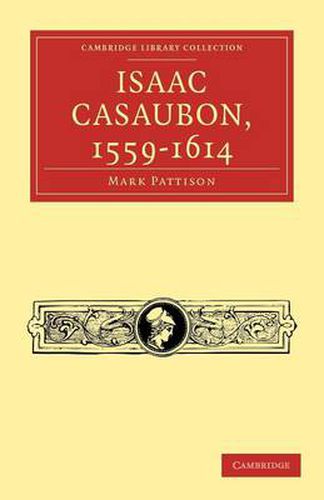Readings Newsletter
Become a Readings Member to make your shopping experience even easier.
Sign in or sign up for free!
You’re not far away from qualifying for FREE standard shipping within Australia
You’ve qualified for FREE standard shipping within Australia
The cart is loading…






The Victorian intellectual Mark Pattison (1813-84) published Isaac Casaubon in 1875, while rector of Lincoln College, Oxford. Casaubon (1559-1614), a French Protestant and distinguished Renaissance scholar, was the author of critical texts and commentaries on a vast corpus of classical authors, including Diogenes Laertius, Theocritus, Aristotle and Strabo. His magnum opus was his text and commentary on Athenaeus’ Deipnosophistae. Pattison’s account is based on letters, diaries, unpublished lecture notes and students’ notes, published works, city archives, and university documents. The work covers Casaubon’s youth, education, scholarly career, and final years spent in England (1610-14), where he influenced the rising ‘Anglican school’. In his image of Casaubon, Pattison paints the picture of the ideal scholar, and through his portrayal reveals his deeply Victorian convictions and sensibilities. The work is an invaluable source for the life of the Renaissance scholar and the ideas and perspectives of the Victorian man.
$9.00 standard shipping within Australia
FREE standard shipping within Australia for orders over $100.00
Express & International shipping calculated at checkout
The Victorian intellectual Mark Pattison (1813-84) published Isaac Casaubon in 1875, while rector of Lincoln College, Oxford. Casaubon (1559-1614), a French Protestant and distinguished Renaissance scholar, was the author of critical texts and commentaries on a vast corpus of classical authors, including Diogenes Laertius, Theocritus, Aristotle and Strabo. His magnum opus was his text and commentary on Athenaeus’ Deipnosophistae. Pattison’s account is based on letters, diaries, unpublished lecture notes and students’ notes, published works, city archives, and university documents. The work covers Casaubon’s youth, education, scholarly career, and final years spent in England (1610-14), where he influenced the rising ‘Anglican school’. In his image of Casaubon, Pattison paints the picture of the ideal scholar, and through his portrayal reveals his deeply Victorian convictions and sensibilities. The work is an invaluable source for the life of the Renaissance scholar and the ideas and perspectives of the Victorian man.